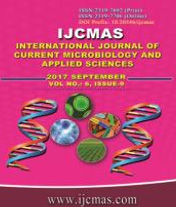


 National Academy of Agricultural Sciences (NAAS)
National Academy of Agricultural Sciences (NAAS)

|
PRINT ISSN : 2319-7692
Online ISSN : 2319-7706 Issues : 12 per year Publisher : Excellent Publishers Email : editorijcmas@gmail.com / submit@ijcmas.com Editor-in-chief: Dr.M.Prakash Index Copernicus ICV 2018: 95.39 NAAS RATING 2020: 5.38 |
Locomotory behaviour of different populations of Punjab collected from three districts (Amritsar, Kapurthala and Ludhiana) was studied with the help of Ethovision. Larvae from different populations travelled more distance when allowed to walk on fenvalerate-treated (496.556 cm) surface for five minutes followed by quinalphos-treated (383.889 cm), spinosad-treated (331.111 cm), flubendiamide-treated (260.222 cm) and chlorantraniliprole-treated (203.556 cm) surfaces. The trend was observed to be same for the speed and opposite for the turn angle. The maximum distance on fenvalrate-treated surface travelled was recorded for the larval populations collected from Ludhiana district (661.33 cm/5 min) followed by Kapurthala district (470.00 cm/5 min) and Amritsar district (358.33cm/5 min). The minimum distance travelled was recorded on the untreated wax-coated paper (78.333 cm). Consequently, speed of larval populations for fenvalrate was also more for Ludhiana district (2.204 cm/s) as compared to those taken from fields of Kapurthala district (1.566 cm/s) followed by Amritsar district (1.194 cm/s). The turn angle of larval population from Amritsar district (264.33â°) was significantly higher as compared to those from Kapurthala (104.33â°) followed by Ludhiana district (35.33â°). Hence, certain pronounced behavioural differences were registered in locomotion of different populations of Punjab and this knowledge would help to find management solutions to Plutella xylostella.
 |
 |
 |
 |
 |